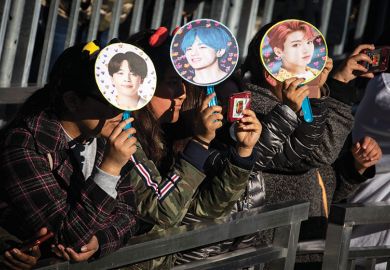Recently, Indian television has gained the upper hand over Indian cinema, which had been independent India's hegemonic form of public culture. Hindi cinema's greatest icon of the 1970s, Amitabh Bachchan, now presents Kaun Banega Crorepati? the Indian version of Who Wants To Be a Millionaire? A huge audience is so hooked on this phenomenon that some cinema owners are considering new times for the traditional 9 pm showing as the programme has lured away the peak-time cinema audience.
Indian cinema and television remain Siamese twins. The cinema depends on television for publicising its films and their music. Television relies heavily on film production and actors, and much of its programming owes a debt to film music, the cinema industry and its stars.
Purnima Mankekar's book is an ethnography of a female, middle-class, New Delhi-based audience's response to Doordarshan, India's state-controlled television, in the early 1990s. Although she draws on Ien Ang's excellent ethnography of television viewing, Watching Dallas (1985), Mankekar sets out her own inquiries in this very specific cultural context.
This was a critical period for Indian television: it followed on from the teleserials of the 1980s, which were the first moves away from a television that largely promoted education and development to one that focused more on entertainment. At this point, Doordarshan transmitted the religious teleserials, the Ramayana and the Mahabharata , which reached unheard-of target audiences. The Mahabharata recorded 99 per cent viewership and seems to have had wider political repercussions. This period also marked the end of the state monopoly of television, as satellite and cable television transmitted from outside India flooded the country. These new channels are watched mostly by the urban middle classes. Doordarshan created new channels in urban areas, but it has remained largely dominant outside the metropolitan cities.
Mankekar's major point of inquiry is how the state interpellates the viewer through discourses of nation, gender and class. These are, however, only the foundations of her concerns, as she turns her attention to a range of topics including the formation of a middle-class identity through consumerism and ideas of duty, the family and education.
The book is divided into three main sections. The first surveys the history of how Indian television presents the family and, in particular, the proliferation of discourses on the ideal Indian woman. The second section examines the roles of gender and sexuality in the way television constructs communities, notably the Hindu community as the norm, and explores television's critique of the link between modernity and secularism. It does so by looking at the religious epics, which were broadcast in a period that witnessed a surge of "Hindu nationalism".
The book's third section examines narratives of violence. It pays special attention to narratives of killing and dying in the name of the nation and also considers stories of partition and the creation of the post-colonial nation. An epilogue brings the book up to date, with a look at satellite and cable television, which arrived after the fieldwork for this study was concluded. These sections are meticulously structured and carefully integrated into the book's concerns.
Mankekar sidesteps the usual criticism of any ethnography - that the sample is unrepresentative - by presenting her informants as living characters. Details of their lives and their aspirations entwine with accounts of their television viewing. Mankekar moves smoothly between her anthropological concerns and her thick descriptions in an engagingly written and very readable style. She avoids a confessional approach, but her genuine concern for these New Delhi women is clear. She wryly observes that miscommunications work both ways: many women think she is staying with her mother in Delhi because her husband has thrown her out for not providing him with children.
In 1995, when organising a conference on public culture in India, I was unable to find anyone to contribute a paper on television. Although several books on Indian television have been published since then, none of them can compare to this study. A thorough, lucid and well-crafted book, Screening Culture, Viewing Politics is essential reading for any student of modern India concerned with television, film, gender and politics. It is a foundational text in the emerging study of consumption and the new middle classes of India.
Rachel Dwyer is senior lecturer in Indian studies, School of Oriental and African Studies, University of London.
Screening Culture, Viewing Politics: An Ethnography of Television, Womanhood, and Nation in Postcolonial India
Author - Purnima Mankekar
ISBN - 0 8223 2390 7 and 2357 5
Publisher - Duke University Press
Price - £42.50 and £14.50
Pages - 429
